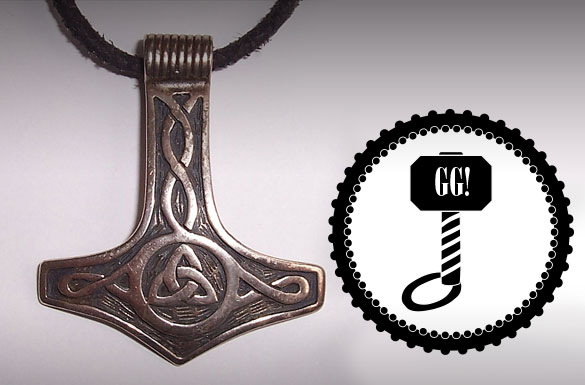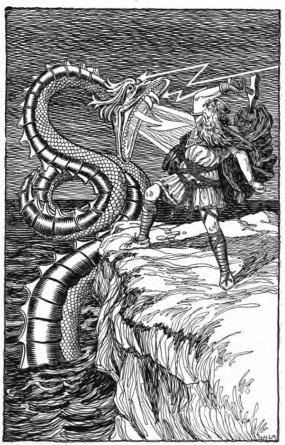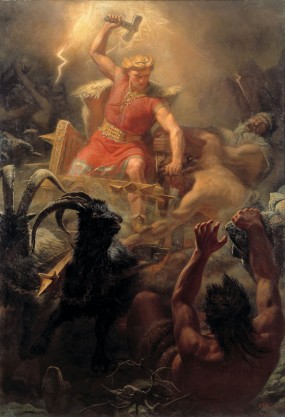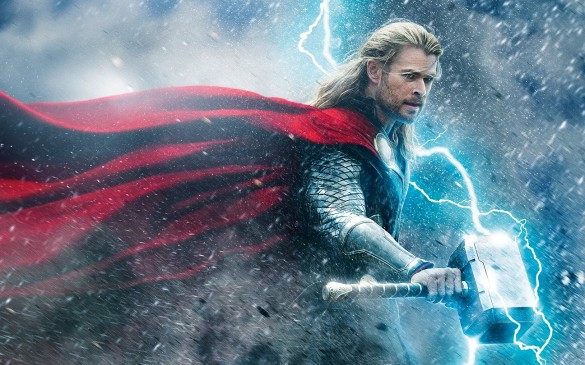 Happy Thor’s Day, everyone! You all know Thor, right? The majestic blond superhero with the hammer and the thunder? Or maybe the red-bearded god and lover of frost giants? Descriptions of the Norse god are vague and far-reaching across time and space. Why the disparity? And how in the world did he land in comic books?
Happy Thor’s Day, everyone! You all know Thor, right? The majestic blond superhero with the hammer and the thunder? Or maybe the red-bearded god and lover of frost giants? Descriptions of the Norse god are vague and far-reaching across time and space. Why the disparity? And how in the world did he land in comic books?
The character known to us as Thor finds his beginnings in the oral tradition of Norse/Scandinavian mythos as the protector of humanity from the frost giants and other unnatural forces, the god (usually) second in power only to Odin. Characteristically wielding a mighty hammer, he served as the brawn to the other Norse gods’ brains.
 From there, accounts of the god’s appearance and travails vary considerably. A significant cause of this variability is the extent of the Viking migrations through settlement and conquest. Each new territory supplied its own backdrop for these stories, some more violent than others. For example, we’re familiar with his role as “god of thunder,” but in Iceland, a land with few thunderstorms, Thor lacked any strong connection with lightning.
From there, accounts of the god’s appearance and travails vary considerably. A significant cause of this variability is the extent of the Viking migrations through settlement and conquest. Each new territory supplied its own backdrop for these stories, some more violent than others. For example, we’re familiar with his role as “god of thunder,” but in Iceland, a land with few thunderstorms, Thor lacked any strong connection with lightning.
Time also had its effect on the role of the god. While he had immense religious significance in pre-Christian Scandinavia, pilgrims seeking to convert the pagans to Christianity attempted to subvert the image of Thor (along with the other Norse gods), connecting it to evil forces. In some areas, this galvanized the local population into more fervent support of their traditional protector. The wearing of a hammer pendant around one’s neck was often seen as a reaction to the cross, and Thor in a sense became a major subject of prayer and a rival to Jesus.
In the end, of course, Christianity won this mythic battle, and it was ironically the Christian clergy, learned in the “art” of writing, who preserved the Norse myths. For that reason, the versions we have today are in many ways positioned more as entertaining stories than the guiding and meaningful tales they represented to those who first told them.
So why did the character of Thor survive all these changes and challenges in time and place? Joseph Campbell’s idea of a “monomyth,” the framework that fits most of the “hero myths” in cultures around the world, makes it clear that the human mind has a subconscious desire to tell certain types of stories more than others. He points to Jung’s archetypes (patterns, images, and characters common to all minds) as the psychological mechanism driving this impulse.
 These archetypal characters have some symbolic meaning outside of any context, but there’s always interest in how they might fare in our own time and place, how their stories might be different if they happened today. The context in which they’re placed then fills in the details not covered by the essential information bound up in the archetype (what we might now call the “meme”). This was very much the case with Thor, and it resulted in renewed interest every time he was adapted to a new cultural environment.
These archetypal characters have some symbolic meaning outside of any context, but there’s always interest in how they might fare in our own time and place, how their stories might be different if they happened today. The context in which they’re placed then fills in the details not covered by the essential information bound up in the archetype (what we might now call the “meme”). This was very much the case with Thor, and it resulted in renewed interest every time he was adapted to a new cultural environment.
In 1963, in a move by Stan Lee, the Odinson made his comic book debut in Marvel Comics’ Journey Into Mystery. This iteration of the thunder god also spawned copies and retellings. This IS comics, after all; nothing seems more appropriate in a milieu of revivals, reboots and retold origins. In his ongoing Marvel sagas, Thor’s mantle has been held by several “people:” two humans, Donald Blake and Eric Masterson; an alien “Beta Ray Bill”; and even a frog. Yes, that’s right. A frog. Still, with all the surface differences, each version had the vital characteristics of the Thor archetype.
But perhaps, you’re most familiar with the golden-haired, Hemsworth edition, from Marvel’s latest and greatest films, The Avengers and Thor: The Dark World, a look that probably stuck since the 1800s when German artists like the composer Richard Wagner attempted to co-opt Norse mythology when manufacturing an ancient Germanic (see: Aryan) ideal. Yet another take on the mythos, the Marvel Cinematic Universe (MCU, for short) modifies long-standing aspects of the story to help spectators believe, however tenuously, that Thor is a character that can share the same screen as their runaway success, Iron Man.
 This is something that recurs in comic book properties frequently. Much in the same way that the environment changed the way the myths were told in the Viking era, Marvel (and by the same token, DC) adapt their stories around the ever-changing socio-political environment. One need look no further than the current popularity of “Agents of S.H.I.E.L.D.” In a post-9/11 America, we’re crafting stories for primetime television about government agencies fielding global threats because these are the dominant archetypes in the collective consciousness, our most prominent memes.
This is something that recurs in comic book properties frequently. Much in the same way that the environment changed the way the myths were told in the Viking era, Marvel (and by the same token, DC) adapt their stories around the ever-changing socio-political environment. One need look no further than the current popularity of “Agents of S.H.I.E.L.D.” In a post-9/11 America, we’re crafting stories for primetime television about government agencies fielding global threats because these are the dominant archetypes in the collective consciousness, our most prominent memes.
This idea of sometimes-conflicting iterations and versions of popular stories (what might in the comic book world be known as a “multiverse”) seems quite at home with the original method of myth-making; not every piece has to fit perfectly together. The idea of a canon, an accepted set of texts exhibiting strict continuity within a particular mythology (and comics are definitely part of our own multimedia mythology), is more a product of the modernist attempt to render all things into “systems” than anything inherent in the practice of storytelling. The postmodern turn giving priority to diverse perspectives seems to have brought us back to this older form. Just look at the mainstreaming of fanfiction for more evidence.
And yet, the prevalence of “reboot culture” has received noticeable backlash from fans and critics alike. This might be due to the accelerated rate at which it’s happening, with studios releasing completely (or not so completely) different versions of the same material year after year. We might have to ask, then: Is our culture really changing so profoundly so rapidly that we need new tellings this frequently? Feel free to comment below with your thoughts.
Further Reading
Campbell, J. (1973). The Hero with a Thousand Faces. Princeton, NJ: Princeton University Press.
Flom, G. T. (1939). The drama of Norse mythology. Scandinavian Studies and Notes, 15(5), 135-157.
Lindow, J. (2001). Norse mythology and the lives of the saints. Scandinavian Studies, 73(3), 437-456.
Lindow, J. (1988). Addressing Thor. Scandinavian Studies, 60(2), 119-136.
Ellis Davidson, H. R. (1965). Thor’s hammer. Folklore, 76(1), 1-15.
